Botany - Transport in Plants: Important Questions | 11th Botany : Chapter 11 : Transport in Plants
Chapter: 11th Botany : Chapter 11 : Transport in Plants
Transport in Plants: Important Questions
Plant
Physiology (Functional Organisation)
Transport
in Plants
Evaluation
1. In a fully turgid cell
a.
DPD = 10 atm; OP = 5 atm; TP = 10 atm
b. DPD = 0 atm; OP = 10 atm; TP =
10 atm
c.
DPD = 0 atm; OP = 5 atm; TP = 10 atm
d.
DPD = 20 atm; OP = 20 atm; TP = 10 atm
2. Which among the following is
correct?
i. apoplast is fastest and operate
in nonliving part
ii. Transmembrane route includes
vacuole
iii. symplast interconnect the
nearby cell through plasmadesmata
iv. symplast and transmembrane
route are in living part of the cell
a.
i and ii
b.
ii and iii
c.
iii and iv
d. i, ii, iii, iv
3. What type of transpiration is
possible in the xerophyte Opuntia?
a.
Stomatal
b.
Lenticular
c. Cuticular
d.
All the above
4. Stomata of a plant open due to
a. Influx of K+
b.
Efflux of K+
c.
Influx of Cl–
d.
Influx of OH–
5. Munch hypothesis is based on
a.
Translocation of food due to TP gradient and imbibition force
b. Translocation of food due to TP
c.
Translocation of food due to imbibition force
d.
None of the above
6.
If the concentration of salt in the soil is too high and the plants may wilt
even if the field is thoroughly irrigated. Explain
7.
Howphosphorylase enzyme open the stomata in starch sugar interconversion
theory?
8.
List out the non-photosynthetic parts of a plant that need a supply of sucrose?
9.
What are the parameters which control water potential?
10.
An artificial cell made of selectively permeable membrane immersed in a beaker
(in the figure). Read the values and answer the following questions?

a.
Draw an arrow to indicate the direction of water movement
b.
Is the solution outside the cell isotonic, hypotonic or hypertonic?
c.
Is the cell isotonic, hypotonic or hypertonic?
d.
Will the cell become more flaccid, more turgid or stay in original size?
e.
With reference to artificial cell state, the process is endosmosis or
exosmosis? Give reasons
Related Topics